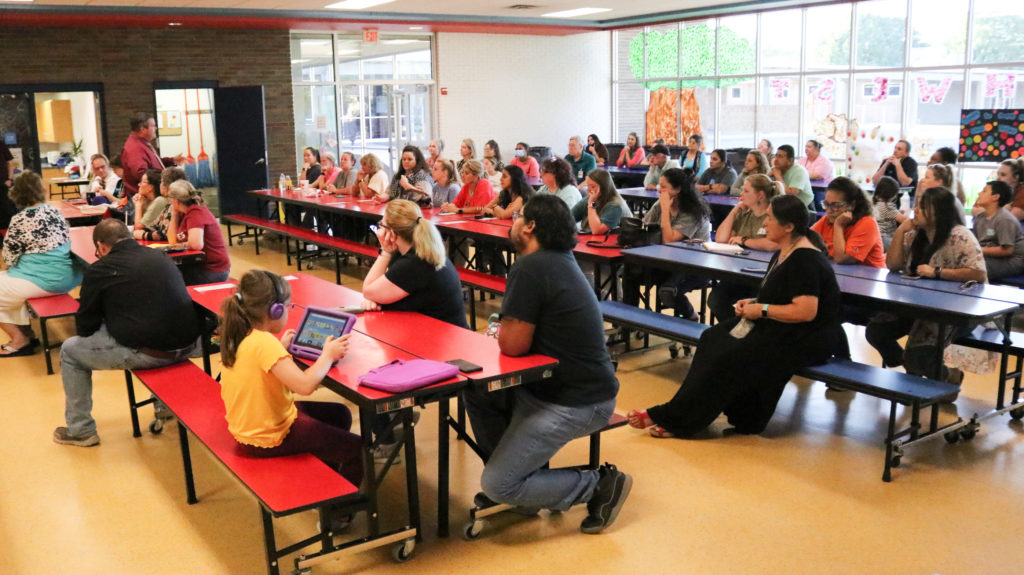

A group of approximately 70 citizens attended as Brownwood ISD Superintendent Dr. Joe Young gave a 45-minute presentation on the subject, then fielded questions for an additional 30 minutes.
Under Project Neighborhood, Woodland Heights, East and Northwest Elementary would house Head Start through fifth grade students, while Coggin would consist of Head Start through sixth grade students.
Currently, Head Start has its own facility, Woodland Heights, East and Northwest Elementary feature Pre-K through third grade students, and Coggin Intermediate is the home to fourth through sixth graders.
The reason for the change, according to Young, is, “as a school district, we need to always look at ways to get better, always look for ways to improve. We as adults have an obligation and a duty to be sure that our schools are providing the best education possible for our kids. It’s not about us because Brownwood ISD was here a long time before you were here or I was here, and it will be here long after these kids are gone. So it’s our opportunity and our obligation to make sure we’re doing the right thing for kids, even if it’s a little uncomfortable. If we go through this process and determine what we’re doing now is the best for kids, I don’t think it will be a waste of time because then as a community we can say we looked at this and looked at it hard and what we’re doing now is the best thing.”
Prior to Project Neighborhood, ideas that were discussed among staff, parents and community members included an early childhood center and moving the third and sixth grades to different campuses. Ultimately, the school district chose Project Neighborhood as the best option.
The question Young then presented to the audience was, “How can our primary grade programs (Head Start through sixth grade) maximize student achievement while continuing to offer a nurturing student-centered neighborhood experience?”
Highlights of Dr. Young’s Project Neighborhood presentation are as follows:
BENEFITS
Young first addressed Head Start, stating the plan would “put kids back into a neighborhood school, which allows them a continuity of service we haven’t been able to offer. It also us to upgrade their facilities. The ones we have now are OK. They’re not the best but their certainly not the worst. But we could move from an aging facility to an upgraded one.”
Young further added that the greatest benefit of the new plan would be kids on elementary campuses for eight years, from Head Start through fifth grade, which would aid in alignment of instruction, growth in assessment, less transition for younger students, an increase in engagement possibilities, and a consistency of services, people and locations.
The aforementioned four BISD campuses have consisted of Head Start through fifth grade in the past, Young reminded the public, but stated that wasn’t reason enough to do it again.
Young also spoke of the additional days program that will be added in the future, which will consist of 30-day optional summer programs for enrichment or remediation. The addition of the program will revert the way in which school time is calculated from minutes back to days. The additional days program will go into effect regardless of the Project Neighborhood vote, Young added.
CHALLENGES
Among the challenges the plan will present include redrawing boundaries such as grade demographics and grandfathered situations regarding students remaining on or returning to specific campuses.
Also, some teachers would be required to move including those from Head Start to elementary campuses, Pre-K through third grade teachers to Coggin, and fourth and fifth grade teachers to Woodland Heights, East and Northwest. Gifted and talented, dyslexia, special education and ESL teachers would have to be modified as well.
Facility needs that must be addressed include playgrounds, furniture size, restrooms, libraries and cafeterias.
TASK FORCES
Now that the public meetings are over, the superintendent said task forces will begin to form to address specific concerns. Young encouraged all concerned citizens to reach out to the school district to be participate on a task force.
Task forces will address:
- Playgrounds/PE/Gym
- Cafeteria
- Busing
- Nursing
- Libraries
- Technology
- Curriculum Resources
- Head Start
- Building Logistics
- Teaching Units – Class Counts
- Admin Staffing
- Counseling
- Rtl/ICs/GT/Dyslexia; SPED/504; ESL
Young then fielded questions – some of which he had answers for and some that will be determined in the future by the task forces – regarding issues such as restroom facilities on campus for Head Start students, teacher assignments, and scheduling a school day, among other topics.
In the coming days, a Frequently Asked Questions document will be available to the public, according to Young.
The community is encouraged to continue to provide ideas, suggestions and feedback by emailing [email protected], or contacting their neighborhood school principal. More information regarding Project Neighborhood can be found online at https://www.brownwoodisd.org/projectneighborhood.
A vote will be taken by the Brownwood ISD Board of Trustees regarding Project Neighborhood in the spring, according to Young, hopefully before spring break, to determine if the plan becomes a reality.
A video of Young’s presentation from Wednesday will be added to this story when it becomes available.
